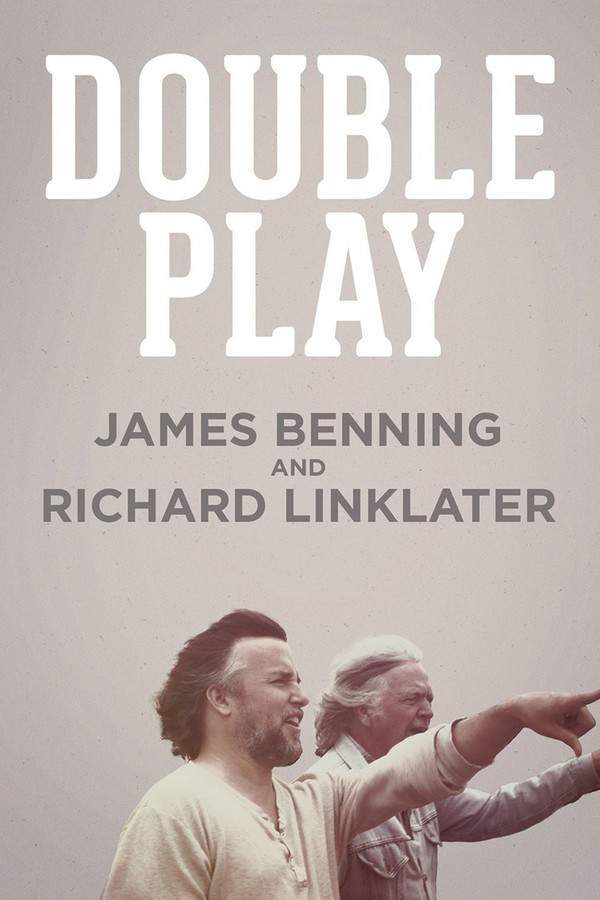
Double Play: James Benning and Richard Linklater 2014
Made by

FilmBuff
Double Play: James Benning and Richard Linklater Plot Summary
Read the complete plot summary and ending explained for Double Play: James Benning and Richard Linklater (2014). From turning points to emotional moments, uncover what really happened and why it matters.
A documentary that delves into the profound friendship between acclaimed filmmakers James Benning and Richard Linklater, this film seamlessly intertwines candid conversations with a rich array of archival footage, examining both their parallels and distinctions in life and their cinematic visions.
The story begins in 1985, when Richard Linklater, a former oil rig worker, initiated a film screening society in Austin, Texas. This society aimed to showcase classic art-house and experimental films to a growing community of film enthusiasts. Eventually evolving into a nonprofit entity, the rebranded Austin Film Society was able to gather enough funding to invite prominent filmmakers, and their first guest was none other than Milwaukee’s own James Benning, who had then relocated to New York.
Upon accepting the invitation, Benning met Linklater, and a genuine personal and intellectual connection blossomed between them. This encounter laid the groundwork for future screenings and multiple interactions. From the late 1960s, Benning had been crafting structural non-narrative films primarily in solitude. Meanwhile, Linklater was just stepping into the world of filmmaking, producing his initial 8 mm and 16 mm shorts. Despite their diverging career paths—Linklater experiencing significant success with big-budget narrative films following the cult achievement of Slacker (1991), while Benning chose to stay true to his modest artistic roots—the two have maintained a steadfast friendship.
This documentary, crafted by film studies professor Gabe Klinger and produced in collaboration with the legendary Andre S. Labarthe, who co-produced the notable French television series Cinema, de notre temps (Cinema of Our Time), seeks to capture the unique bond between Benning and Linklater. Over several days in Austin and Bastrop, Texas, the filmmakers present Benning’s works at the Austin Film Society, engage in friendly baseball games at Linklater’s residence, visit significant filming locations from the past, and share personal stories over long meals and serene hikes.
By blending this newly filmed content with comprehensive archival material, Double Play endeavors to uncover not only the similarities shared by Benning and Linklater but also the distinct differences that characterize their artistic journeys and philosophies. Through this intricate tapestry of friendship and film, viewers are invited to reflect on the expansive landscape of cinema and the enduring bonds that it can create.
Double Play: James Benning and Richard Linklater Timeline
Follow the complete movie timeline of Double Play: James Benning and Richard Linklater (2014) with every major event in chronological order. Great for understanding complex plots and story progression.
Richard Linklater's Film Society Initiation
In 1985, Richard Linklater, a former oil rig worker, established a film screening society in Austin, Texas. The aim was to showcase classic art-house and experimental films to an emerging group of cinephiles, fostering a community around independent cinema.
Formation of Austin Film Society
The film society eventually incorporated as a nonprofit organization named the Austin Film Society. This transformation enabled them to raise funds needed to bring in filmmakers and expand their programming significantly.
James Benning's First Visit
The Austin Film Society successfully raised enough funds to invite Milwaukee native James Benning, who at the time was living in New York City. His acceptance of the invitation marked the beginning of a significant friendship and collaboration.
Initial Meeting of Benning and Linklater
Upon Benning's arrival in Austin, he met Richard Linklater, and the two immediately connected both personally and intellectually. This meeting laid the groundwork for their future collaborations and a deeper exploration of their artistic similarities and differences.
Development of a Personal Bond
Linklater and Benning forged an enduring friendship that involved discussions about life and cinema. Their mutual interests and philosophies about filmmaking became a foundation for a supportive relationship that would transcend their careers.
Benning's Independent Filmmaking
Starting in the late 1960s, James Benning had been creating structural non-narrative films largely independently. His focus on experimental film techniques contrasted with the narrative style that Linklater would later embrace in mainstream cinema.
Linklater's Breakthrough with Slacker
In 1991, Richard Linklater gained cult fame with his film Slacker, which showcased his unique narrative style. This success propelled him into Hollywood, leading to the creation of larger-budget narrative films that would further differentiate his path from Benning’s.
Contrasting Career Paths
As Linklater achieved commercial success, Benning remained connected to his modest filmmaking roots, often flying under the radar within mainstream film culture. This divergence in career paths highlighted the different philosophies that each filmmaker held towards cinema.
Documentary Development
Gabe Klinger, a film studies professor, aimed to document the unique friendship between Benning and Linklater. Collaborating with producer Andre S. Labarthe, they set out to explore their connections and divergences through film.
Filming in Austin and Bastrop
Filming took place over several days in Austin and Bastrop, Texas, where Benning and Linklater interacted while presenting Benning’s films at the Austin Film Society. The documentary captures intimate moments that underscore their friendship.
Revisiting Old Shooting Locations
During the filming period, Benning and Linklater revisited old shooting locations. These visits allowed them to reflect on their pasts and the evolution of their filmmaking journeys, adding layers of nostalgia to the narrative.
Cinematic Conversations
The documentary features filmed conversations between Benning and Linklater, providing insights into their filmmaking philosophies. These discussions explore not only their similarities but also their stark differences in approach to cinema.
Shared Meals and Hikes
As part of their exploration, the filmmakers shared long meals and hikes, strengthening their bond. This informal setting allowed them to engage in deep conversations about life, art, and the nature of their friendship.
Combining Archival Elements
The documentary, titled Double Play, integrates newly filmed material with extensive archival footage. This unique blend creates a comprehensive portrait of their friendship, highlighting the evolution of their artistic journeys.
Thematic Exploration
Double Play aims to explore the connections and contrasts between the two filmmakers, ultimately shedding light on their individual journeys in the realm of cinema. This exploration reveals both the beauty and complexity of their friendship over the years.
Double Play: James Benning and Richard Linklater Characters
Explore all characters from Double Play: James Benning and Richard Linklater (2014). Get detailed profiles with their roles, arcs, and key relationships explained.
Richard Linklater
Richard Linklater is known for his innovative storytelling and contribution to independent cinema. His journey from starting a film society in Austin to directing widely recognized narrative films illustrates his commitment to cinema and community. Linklater's work often examines the passage of time and the intricacies of human relationships.
James Benning
James Benning is a pioneering figure in structural film, celebrated for his contemplative and non-narrative works. His commitment to art cinema set him apart from mainstream filmmakers, showcasing a unique voice that challenges conventional storytelling. Benning's films often reflect a deep engagement with the landscape and the passage of time.
Double Play: James Benning and Richard Linklater Settings
Learn where and when Double Play: James Benning and Richard Linklater (2014) takes place. Explore the film’s settings, era, and how they shape the narrative.
Time period
1980s
The 1980s was a pivotal decade for independent cinema in the United States, with filmmakers like Richard Linklater emerging from grassroots movements. This period saw a push towards artistic expression outside of the Hollywood mainstream, leading to significant cultural developments and the rise of iconic films that defined a generation.
Location
Austin, Texas, Bastrop, Texas
Austin, Texas, known for its vibrant arts scene and live music, is a cultural hub that has birthed many renowned filmmakers. Bastrop, a small city nearby, offers a more rustic, natural setting that contrasts with the urban landscape of Austin, embodying the spirit of Texas's diverse environments.
Double Play: James Benning and Richard Linklater Themes
Discover the main themes in Double Play: James Benning and Richard Linklater (2014). Analyze the deeper meanings, emotional layers, and social commentary behind the film.
🎥
Friendship
The theme of friendship is central to the documentary, showcasing the deep bond between Benning and Linklater. Their relationship illustrates how personal connections can shape artistic visions and foster creative environments. Through their interactions, the film highlights the importance of mentorship and collaborative spirit in the world of cinema.
🎬
Cinematic Divergence
The film explores the contrasting paths of its two subjects, with Linklater moving towards mainstream success and Benning remaining in the realm of independent filmmaking. This divergence reflects broader themes in the film industry regarding commercial versus art-driven projects. It challenges viewers to consider the value and impact of different cinematic approaches.
Featured on this page

What's After the Movie?
Not sure whether to stay after the credits? Find out!
Explore Our Movie Platform
New Movie Releases (2025)
Famous Movie Actors
Top Film Production Studios
Movie Plot Summaries & Endings
Major Movie Awards & Winners
Best Concert Films & Music Documentaries
© 2025 What's After the Movie. All rights reserved.




